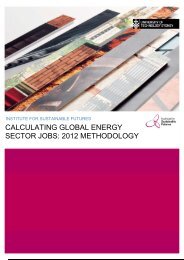download the mexico energy revolution scenario
download the mexico energy revolution scenario
download the mexico energy revolution scenario
Create successful ePaper yourself
Turn your PDF publications into a flip-book with our unique Google optimized e-Paper software.
image A YOUNG INDIGENOUS NENET BOY PRACTICES WITH HIS ROPE. THE BOYS ARE GIVEN A ROPE<br />
FROM PRETTY MUCH THE MOMENT THEY ARE BORN. BY THE AGE OF SIX THEY ARE OUT HELPING<br />
LASSOING THE REINDEER. THE INDIGENOUS NENETS PEOPLE MOVE EVERY 3 OR 4 DAYS SO THAT<br />
THEIR REINDEER DO NOT OVER GRAZE THE GROUND AND THEY DO NOT OVER FISH THE LAKES. THE<br />
YAMAL PENINSULA IS UNDER HEAVY THREAT FROM GLOBAL WARMING AS TEMPERATURES INCREASE<br />
AND RUSSIAS ANCIENT PERMAFROST MELTS.<br />
© GP/WILL ROSE<br />
Germany, Spain and Denmark. Operators are paid a fixed price<br />
for every kWh of electricity <strong>the</strong>y feed into <strong>the</strong> grid. In Germany<br />
<strong>the</strong> price paid varies according to <strong>the</strong> relative maturity of <strong>the</strong><br />
particular technology and reduces each year to reflect falling<br />
costs. The additional cost of <strong>the</strong> system is borne by taxpayers or<br />
electricity consumers.<br />
The main benefit of a FIT is that it is administratively simple and<br />
encourages better planning. Although <strong>the</strong> FIT is not associated with<br />
a formal Power Purchase Agreement, distribution companies are<br />
usually obliged to purchase all <strong>the</strong> production from renewable<br />
installations. Germany has reduced <strong>the</strong> political risk of <strong>the</strong> system<br />
being changed by guaranteeing payments for 20 years. The main<br />
problem associated with a fixed price system is that it does not lend<br />
itself easily to adjustment – whe<strong>the</strong>r up or down - to reflect changes<br />
in <strong>the</strong> production costs of renewable technologies.<br />
• Fixed premium systems sometimes called an “environmental<br />
bonus” mechanism, operate by adding a fixed premium to <strong>the</strong><br />
basic wholesale electricity price. From an investor perspective,<br />
<strong>the</strong> total price received per kWh is less predictable than under a<br />
feed-in tariff because it depends on a constantly changing<br />
electricity price. From a market perspective, however, it is argued<br />
that a fixed premium is easier to integrate into <strong>the</strong> overall<br />
electricity market because those involved will be reacting to<br />
market price signals. Spain is <strong>the</strong> most prominent country to<br />
have adopted a fixed premium system.<br />
• Tax credits as operated in <strong>the</strong> US and Canada, offer a credit<br />
against tax payments for every kWh produced. In <strong>the</strong> United<br />
States <strong>the</strong> market has been driven by a federal Production Tax<br />
Credit (PTC) of approximately 1.8 cents per kWh. It is adjusted<br />
annually for inflation.<br />
renewable quota systems<br />
Two types of renewable quota systems have been employed -<br />
tendering systems and green certificate systems.<br />
• Tendering systems involve competitive bidding for contracts to<br />
construct and operate a particular project, or a fixed quantity of<br />
renewable capacity in a country or state. Although o<strong>the</strong>r factors<br />
are usually taken into account, <strong>the</strong> lowest priced bid invariably<br />
wins. This system has been used to promote wind power in<br />
Ireland, France, <strong>the</strong> UK, Denmark and China. The downside is<br />
that investors can bid an uneconomically low price in order to<br />
win <strong>the</strong> contract, and <strong>the</strong>n not build <strong>the</strong> project. Under <strong>the</strong> UK’s<br />
NFFO (Non-Fossil Fuel Obligation) tender system, for example,<br />
many contracts remained unused. It was eventually abandoned. If<br />
properly designed, however, with long contracts, a clear link to<br />
planning consent and a possible minimum price, tendering for<br />
large scale projects could be effective, as it has been for offshore<br />
oil and gas extraction in Europe’s North Sea.<br />
• Tradable green certificate (TGC) systems operate by offering<br />
“green certificates” for every kWh generated by a renewable<br />
producer. The value of <strong>the</strong>se certificates, which can be traded on a<br />
market, is <strong>the</strong>n added to <strong>the</strong> value of <strong>the</strong> basic electricity. A green<br />
certificate system usually operates in combination with a rising<br />
quota of renewable electricity generation. Power companies are<br />
bound by law to purchase an increasing proportion of renewables<br />
input. Countries which have adopted this system include <strong>the</strong> UK<br />
and Italy in Europe and many individual states in <strong>the</strong> US, where<br />
it is known as a Renewable Portfolio Standard. Compared with a<br />
fixed tender price, <strong>the</strong> TGC model is more risky for <strong>the</strong> investor,<br />
because <strong>the</strong> price fluctuates on a daily basis, unless effective<br />
markets for long-term certificate (and electricity) contracts are<br />
developed. Such markets do not currently exist. The system is also<br />
more complex than o<strong>the</strong>r payment mechanisms.<br />
4. renewables for heating and cooling<br />
The crucial requirement for both heating and cooling is often<br />
forgotten in <strong>the</strong> <strong>energy</strong> mix. In many regions of <strong>the</strong> world, such as<br />
Europe, nearly half of <strong>the</strong> total <strong>energy</strong> demand is for<br />
heating/cooling. This demand can be met economically without<br />
relying on fossil fuels.<br />
Policies should make sure that specific targets and appropriate<br />
measures to support renewable heating and cooling are part of any<br />
national renewables strategy. These should include financial<br />
incentives, awareness raising campaigns, training of installers,<br />
architects and heating engineers, and demonstration projects. For<br />
new buildings, and those undergoing major renovation, an obligation<br />
to cover a minimum share of heat consumption by renewables<br />
should be introduced, as already implemented in some countries.<br />
At <strong>the</strong> same time, increased R&D efforts should be undertaken,<br />
particularly in <strong>the</strong> fields of heat storage and renewable cooling.<br />
Governments should also promote <strong>the</strong> development of combined heat<br />
and power generation in those industrial sectors that are most<br />
attractive for CHP - where <strong>the</strong>re is a demand for heat ei<strong>the</strong>r directly<br />
or through a local (existing or potential) district heating system.<br />
Governments should set targets and efficiency standards for CHP and<br />
provide financial incentives for investment in industrial installations.<br />
5. <strong>energy</strong> efficiency and innovation<br />
Action: Set stringent efficiency and emissions standards for<br />
appliances, buildings, power plants and vehicles<br />
Policies and measures to promote <strong>energy</strong> efficiency exist in many<br />
countries. Energy and information labels, mandatory minimum<br />
<strong>energy</strong> performance standards and voluntary efficiency agreements<br />
are <strong>the</strong> most popular measures. Effective government policies<br />
usually contain two elements - those that push <strong>the</strong> market through<br />
standards and those that pull through incentives - and have proved<br />
to be an effective, low cost way to coordinate a transition to more<br />
<strong>energy</strong> efficiency.<br />
The Japanese front-runner programme, for example, is a regulatory<br />
scheme with mandatory targets which gives incentives to<br />
manufacturers and importers of <strong>energy</strong>-consuming equipment to<br />
continuously improve <strong>the</strong> efficiency of <strong>the</strong>ir products. It operates by<br />
allowing today’s best models on <strong>the</strong> market to set <strong>the</strong> level for<br />
future standards.<br />
In <strong>the</strong> residential sector in industrialised countries, standby power<br />
consumption ranges from 20 to 60 watts per household, equivalent to<br />
4 to 10% of total residential <strong>energy</strong> consumption. Yet <strong>the</strong> technology<br />
is available to reduce standby power to 1 watt. A global standard, as<br />
proposed by <strong>the</strong> IEA, could mandate this reduction. Japan, South<br />
Korea and <strong>the</strong> state of California have not waited for this international<br />
approach and have already adopted standby standards.<br />
103<br />
9<br />
climate & <strong>energy</strong> policy | TARGETS AND ACTION



![Energy [R]evolution - European Commission](https://img.yumpu.com/49109324/1/184x260/energy-revolution-european-commission.jpg?quality=85)


![5905 gp [eu rev]csfr4.qxd - Energy [R]evolution](https://img.yumpu.com/42305023/1/184x260/5905-gp-eu-revcsfr4qxd-energy-revolution.jpg?quality=85)


![5905 gp [eu rev]csfr4.qxd - Energy [R]evolution](https://img.yumpu.com/28729264/1/184x260/5905-gp-eu-revcsfr4qxd-energy-revolution.jpg?quality=85)